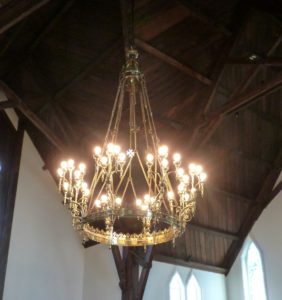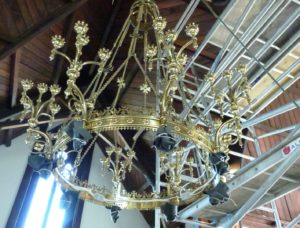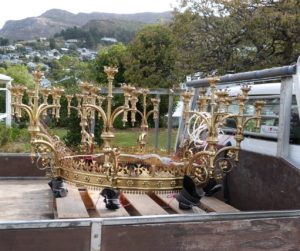Like St Saviour’s Church it too has had its adventures. Initially rescued from Holy Trinity by Mark, Elizabeth and Carl Penn, the late Captain John Cleaver and the Lyttelton Fire Brigade, after the February 2011 earthquakes, it spent some time in John’s garage mezzanine floor before being hoisted down and transported to the Grange Street Warehouse. There it sat until Celia Falloon of Church Property Trustees in consultation with the parish arranged for it to be transported on the back of a truck to Lyndon Rowe of JKL Solutions. Here it was expertly put back together and rewired and thanks to the diligence of all those involved only one small piece had to be replicated.
Thursday May 5th , and once more on the back of a truck , it came back through the tunnel. With scaffolding in place it was slowly and gently hoisted into position. Arnold Jensen Electricians wired it up the next day, the forty bulbs were inserted and the lights went on!


But how did Lyttelton acquire this corona in the first place? There have always been rumours that it  was meant for the Anglican Cathedral or even the Roman Catholic Cathedral and it somehow never left the port. Captain Cleaver wrote in his Parish History that it was the gift of the friends of J M Heywood and although now we know a little more of its background, that remains the only known fact about its provenance.
was meant for the Anglican Cathedral or even the Roman Catholic Cathedral and it somehow never left the port. Captain Cleaver wrote in his Parish History that it was the gift of the friends of J M Heywood and although now we know a little more of its background, that remains the only known fact about its provenance.
Joseph Martin Heywood arrived in New Zealand in 1851 on board the Steadfast. On his arrival he became a storekeeper with Edward Watson Tippetts and Alfred Silk who had been cabin passengers with him on board ship. This business was dissolved by mutual consent in July 1855 prior to Heywood’s return to England. During this time he married Emma Ivall and then returned with her to Lyttelton on board the Egmont, the same ship that transported the future Bishop of the Diocese of Christchurch and his family. Just under two years later the columns of the Lyttelton Times report the founding of the Canterbury Steam Navigation Company with J Martin Heywood as its manager. The advertisement of April 14 1858 indicates that its purpose was to facilitate “ the communication between Lyttelton and the various shipping ports of the Province”.
On 10 April 1860 Bishop Harper consecrated the second Church of the Holy Trinity in Lyttelton on a fine, but windy day, but it was not until 26 September 1860 that the “Local Intelligence” column of the Lyttelton Times announced the “very liberal gift of the friends of Mr and Mrs J M Heywood of this town, who have long taken the warmest interest in all that concerns the church, and whose friends in England evidently enter into and participate in those feelings”. That liberal gift was of course the “ corona lucis” or crown of light. Originally lit by forty candles, the reporter concluded “that in elegance of design and richness of detail we can recall few that are equal and not one that is superior to that which now hangs over the centre transept of the church.”
The next questions must be where did it come from, and how did it get to Lyttelton? Despite a thorough search by Lyndon Rowe as he was undertaking the repairs, unfortunately no makers mark appears on the corona. However there is a single clue concerning its arrival in Lyttelton. “Shipping News” was a regular feature of the Lyttelton Times, listing not only the arrivals of individuals, but also the cargo that was destined for individuals and firms. The newspaper of September 15th announced the arrival on September 12th 1860 of the Chapman with a Miss Heywood on board. The cargo included 1 box for Heywood. Is this the box that contained the corona? Perhaps we will never know, but it is the closest we have come to date.
The corona now hangs again, forty bulbs instead of forty candles, but the crown of light is no less magnificent. A liberal gift indeed.
